“I’m a mess whenever I think about 9/11 for too long. I know that my brain will never truly comprehend what I saw that day”.
For most people who were unfortunate to find themselves amongst the terrible event on 9/11, their first action would have been to get away as quickly as possible. However, photographers are not most people…
Phil Penman, a Photojournalist based in New York, was at home when he first received a call to inform him a plane had hit the World Trade Center. He has kindly taken the time to talk to us and revisit what happened during the following two hours on that tragic day on September 11th, 2001.
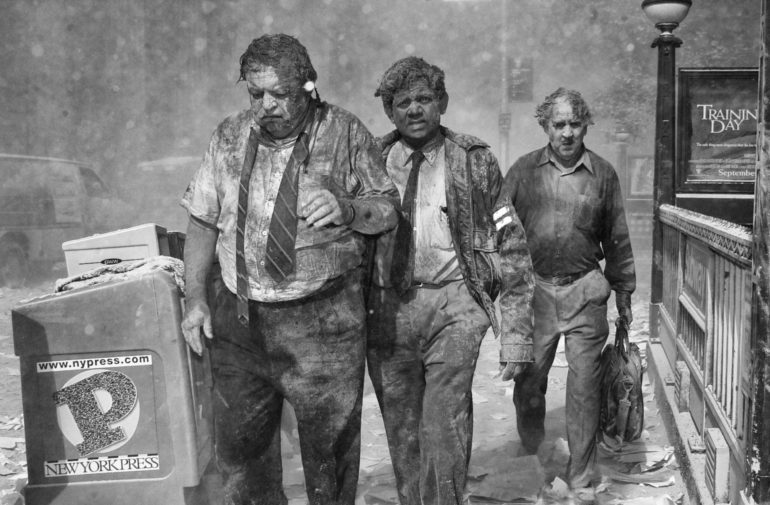
Phoblographer: It is 17 years since the attack on the World Trade Center. What was the feeling like when you first got the call that one of the towers had been hit by a plane?
Phil – I actually did not pick up the call. I had been working for months straight. I just got home from shooting a celebrity event, so all I was interested in was getting some sleep. When my phone rang I left it because I knew it would be work.
I heard a ping informing me that a voicemail had been left on my cell. It was my colleague informing me that one the towers had been hit by a plane. At this point, nobody knew it was a terror attack.
I turned on the television, and when I saw the smoke billowing out of the towers, I grabbed some clothes, my camera bag and got on my bike as fast as I could.
Because I did not know much about what was happening I just went [to the World Trade Centre] and thought about where would be a good vantage point.
Phoblographer: As a photographer, how do you prepare yourself mentally, knowing you are going into what could potentially be an extremely dangerous environment?
Phil – On this occasion, I simply did not think. I’ve had to do a lot of dangerous stuff in my time. I have put myself in situations before where I knew I was not coming back alive if I went with a particular person. There have been times where instinct was telling me not to do something.
Just last week I was going through my old raw images from 9/11. In one picture you see an ambulance to the right and at the time I was looking down the road. I got a sixth sense telling me not to walk down the road.
Whilst looking at the image, I noticed one of the towers was still standing. If I was to have walked down that road I would most certainly not be here today. The second tower collapsed shortly after the image was shot.
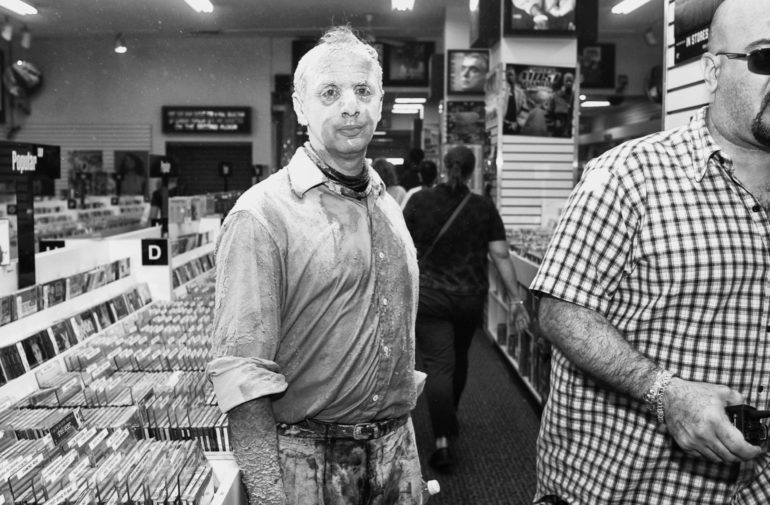
Phoblographer: There is a photograph of a man covered in thick debris. When you take such an image, is there a dialogue or do you try to shoot as candidly as possible?
Phil – The man had run into the store screaming, he could not believe he had made it. After waiting a few minutes, I asked if he minded if I took a couple of pictures.
Once we could see out of the front window of the store, I went outside. It was then that I started to see people walking towards me in their weakest and most vulnerable of moments.
You ask yourself, can I do this?
The scale of the event was so big. I just started to take pictures and would ask people if they were okay.
Phoblographer: As you arrived at the scene, the second tower had already been hit. At any point did you think about turning around and going home to safety?
Phil – My first images were taken from West Broadway. They showed both the towers in flames. I did not really think about my safety at his point.
Now I know how close I was to losing my life, however, it took me quite a few years before I really understood this.
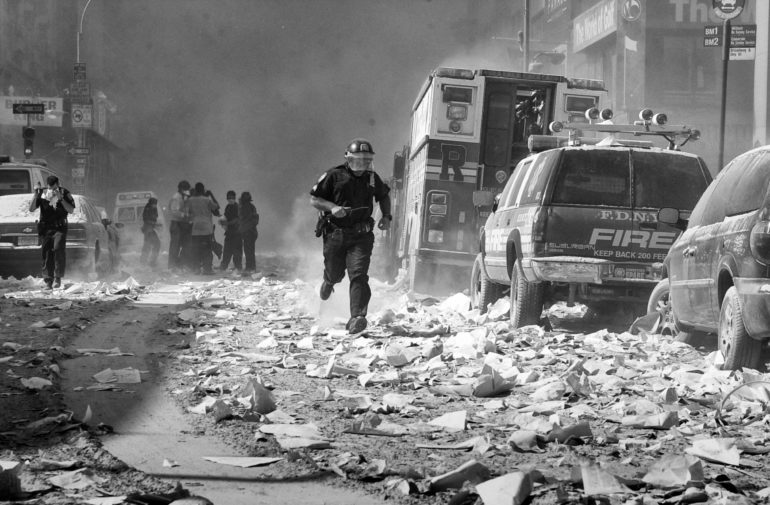
Phoblographer: When you photograph a city, more so the people, you get an intimate understanding of the nuanced traits that make the city flow. What was the response like from the people after the attacks on 9/11?
Phil – New Yorkers are amazing. If someone slips on a pavement, 5 people will help pick them up.
So after 9/11, it does not shock me the way people responded. Right from the get-go, the people were doing whatever they could to help.
The city could have slipped into darkness. Instead, all it did was make us even stronger and brought us together as one.
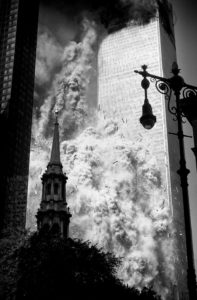 Phoblographer: You were rather close to the first tower when it came down. At what point did you decide that you needed to stop shooting and seek safety?
Phoblographer: You were rather close to the first tower when it came down. At what point did you decide that you needed to stop shooting and seek safety?
Phil – I watched through my viewfinder and saw how the dust cloud and World Trade Center were coming closer and closer to me. I was stood about a block away. Just in front of the church on Broadway.
It wasn’t until some firemen grabbed me and told me to run with them into J&R music. I’m not sure what I would have done had they not done that.
Had they not saved me from being caught in the dust cloud, I would have severe health problems today.
Phoblographer: Let’s discuss your mental state after the event. Was there an urge to develop the film as quickly as possible, or did you need to take time out to regroup first?
Phil – Being a press photographer you do not have time. The first call that was able to come through on my cell was my boss. He said, “I know you do not want to leave, but you have to get those pictures moving now”.
The world’s press was waiting for any material to come in. I started running.
In retrospect, I would not have left. I should have stayed photographing, as I knew once I left, there no way I was going to be able to get back down there.
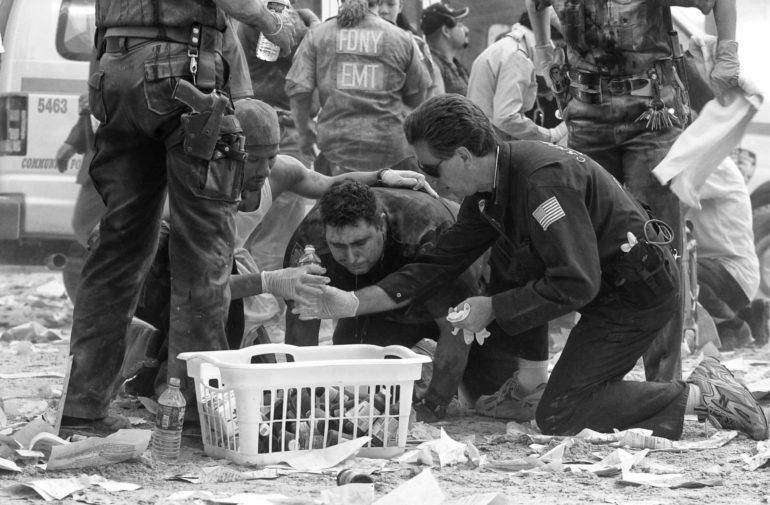
Phoblographer: Did you experience any psychological trauma after the attacks?
Phil – To be honest, I am a mess whenever I think about 9/11 for too long. I know my brain will never truly comprehend what I saw that day. I find going through the pictures and talking about it has helped me though.
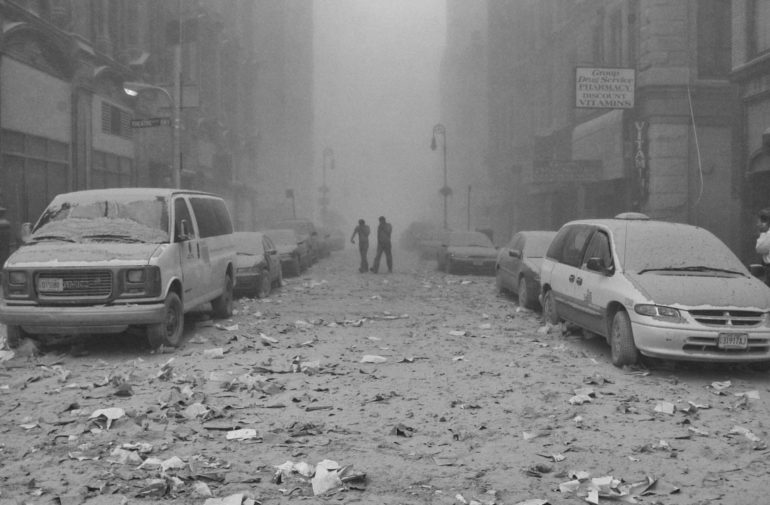
Phoblographer: Finally, in the result of such a catastrophic event you have a very emotive collection of images. What do you think and feel when you view them 17 years later?
Phil – It still does not feel like it was that long ago. I still have flashbacks in my mind and will break down in tears from time to time.
I did go for a meeting at the [9/11 Memorial] Museum. I had to get out quick as it was too painful. They have done an amazing job with the Museum.
What is crazy to me, is when I see teenagers and know they were not even born yet when it happened. How could they understand?
It’s like the first and second world war. How can we even begin to understand what our elders did for us? Over 50 million people died in the second world war.
Can you imagine if that happened today?
Phil Penman is a British award-winning Photojournalist based in New York. Be sure to visit his website and Instagram to find more information about his career and work. All images used with permission.
Related
from The Phoblographer http://bit.ly/2MrARKS
via IFTTT
